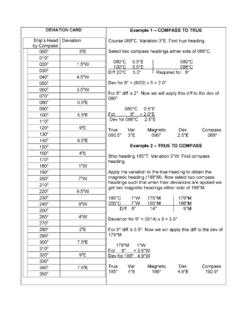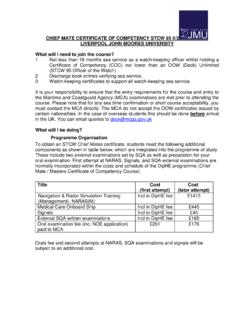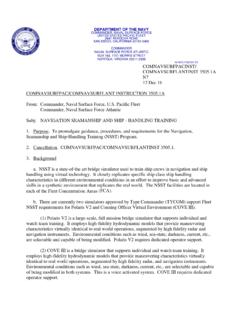Transcription of A PRACTICAL GUIDE TO THE RULES OF THE ROAD - …
1 A PRACTICAL GUIDE TO THE RULES OF THE ROAD For OOW, Chief Mate and Master Students FARHAN SAEED First published in 2010 by SeamanshipTutor Ltd, 57 Melbrack Road, Liverpool, L18 9SF Email: SeamanshipTutor Ltd, 2010 All rights reserved. No part of this publication may be reproduced, stored in a retrieval system, or transmitted in any form or by any means, electronic, mechanical, photocopying, recording or otherwise, without the permission of the publishers. Although great care has been taken with the writing and production of this publication, neither SeamanshipTutor Ltd nor the author can accept any responsibility for any errors, omissions or their consequences.
2 This publication has been prepared to deal with the subject of collision regulations. This should not however, be taken to mean that this publication deals with comprehensively with all the issues of the subject. The opinions expressed are those of the author only and are not necessarily to be taken as policies or views of any organisation with which he has any connection. ISBN 978-0-9563971-1-9 Preface The purpose of this book is to provide a form of self teaching of RULES of the road and self examination on the navigation lights and related situations that could be seen at sea or asked at the oral examinations for the certificate of competency.
3 This book is divided into two main sections. The first section contains simple explanations of the RULES , while the second section covers more than fifty situations, exam questions and model answers. The RULES , explanations and model answers are the views of the author and not necessarily the view of courts and regulators. Interactive navigation light identification software is available after the explanation of the RULES . This contains enough navigation light examples required for the certificate of competency examinations. All questions are asked randomly. You will need to identify the light and then check the answer at each page.
4 You need to master these simple tests before you go for your oral examination. About The Author Farhan Saeed joined merchant navy in 1988 and was engaged in worldwide trading as deck officer on General Cargo ships, Container vessels and Passenger vessels with Pakistan National Shipping Corporation. His marine studies, leading to Master Mariner qualification, have been undertaken in Pakistan Marine Academy, Australian Maritime College and Fleetwood Nautical Campus in the UK. He obtained an MSc, Information Systems, in 2001 from University of Sunderland, UK.
5 He obtained membership of the Institute of Chartered Shipbrokers in 2005. He was a prize winner in the subject of Port Agency in the Institute of Chartered Shipbrokers examinations. After six years of teaching nautical science in Fleetwood Nautical Campus, he is currently engaged as Senior Lecturer in Maritime Operations in Liverpool John Moores University, UK. He is also conducting a Phd research in the field of seafarer s certification system. Acknowledgements The author and publishers would like to thank the following for reviewing the book and providing valuable advice during the several stages of the preparation of the book; Dr.
6 Alan Wall Dr. Paul Hughes Mr. Vikas Patra Capt. Shan Hashmi CONTENTS Introduction 1 Part A (General) - Explanations 3 Part B (Steering and Sailing RULES ) Explanations 7 Part C (Lights and Shapes) With Illustrations 31 Part D (Sound and Light Signals) 65 Part E Exemptions 69 Open Sea Situations 71 TSS / Narrow Channel situations 107 Restricted visibility situations 116 Annexes 126 International Regulations for Preventing Collision at Sea 1972 (including amendments up to 2001)
7 Divided into five main parts and four auxiliary annexes. This is as follows; PART A GENERAL PART B STEERING AND SAILING RULES Section I - Conduct of vessels in any conditions of visibility Section II - Conduct of vessels in sight of one another Section III - Conduct of vessels in restricted visibility PART C LIGHTS AND SHAPES PART D SOUND AND LIGHT SIGNALS PART E EXEMPTIONS ANNEX I POSITIONING AND TECHNICAL DETAILS OF LIGHTS AND SHAPES ANNEX II ADDITIONAL SIGNALS FOR FISHING VESSELS FISHING IN
8 CLOSE PROXIMITY ANNEX III TECHNICAL DETAILS OF SOUND SIGNAL APPLIANCES ANNEX IV DISTRESS SIGNALS The regulations consist of 38 RULES in all. Part A covers general RULES (1-3) covering application of the RULES , responsibilities and definitions. Part B contains the steering and sailing RULES (4-19), subdivided into three sections according to the degree of visibility. It is very important to have a thorough understanding of this part. The RULES of this part set out the actions of every mariner in all conditions of visibility. RULES of section I (4-10) of part B apply in any condition of visibility.
9 RULES of section II (11-18) are applicable to vessels in sight of one another. Third section consists of rule 19 which is applicable in restricted visibility only. 1 PART B - STEERING AND SAILING RULES Section I - Conduct of vessels in any condition of visibility Rule 4 Application RULES in this Section apply in any condition of visibility. Rule 5 Lookout Every vessel shall at all times maintain a proper look-out by sight and hearing as well as by all available means appropriate in the prevailing circumstances and conditions so as to make a full appraisal of the situation and of the risk of collision.
10 It is absolutely essential to maintain an all round lookout, at all times, by sight and hearing and by all available means including radar and AIS in all kinds of visibility. Extra lookouts should be posted in restricted visibility. The early detection of a target will help to make an early judgement of the situation, and of the risk of collision. Rule 6 Safe speed Every vessel shall at all times proceed at a safe speed so that she can take proper and effective action to avoid collision and be stopped within a distance appropriate to the prevailing circumstances and conditions.







